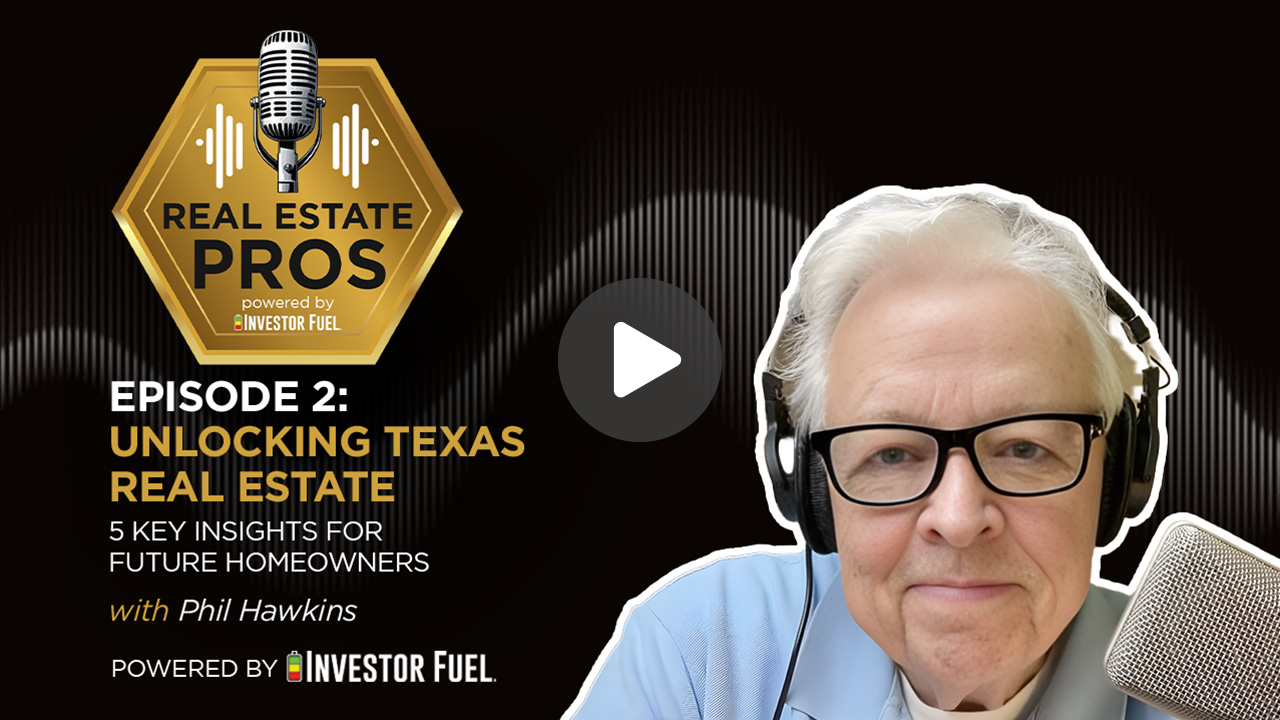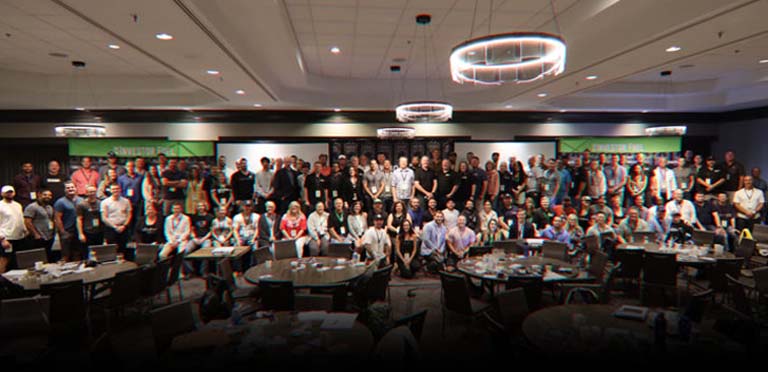
Show Summary
In this conversation, Phil Hawkins and Dylan Silver discuss the challenges and opportunities in the Texas real estate market, focusing on property taxes, education, community impact, and economic indicators. They explore the implications of high homeowners and auto insurance rates, the importance of improving school districts, and predictions for the future of the housing market, including potential price increases and investment strategies.
Resources and Links from this show:
Listen to the Audio Version of this Episode
Investor Fuel Show Transcript:
Phil Hawkins (00:00.121)
onto something here you know we’re leaving a lot of stuff in the air about people that people could learn from okay yeah okay
Dylan Silver (00:02.099)
I want
Dylan Silver (00:07.694)
We may splice this into a second episode here, but I wanted to ask you really about, is there anything that we could be doing in Texas? And I don’t know that there is, but we talk about the high property taxes in Texas, and you talk about permits in California. Where else could Texas raise money from to fund its state other than property taxes?
Phil Hawkins (00:30.673)
Well, the state of Texas has a surplus of in the neighborhood $20 billion per year. somewhere that money, know, Governor Abbott, I think just signed a bill revising or reducing or in some way changing the real estate tax rates for the state of Texas. And I haven’t seen the details of that, but apparently
Dylan Silver (00:52.45)
Yeah, I heard about that.
Phil Hawkins (00:56.219)
Everybody’s kind of yawning. know, it’s too little, too late. It’s a nice gesture, but it doesn’t really address the real problem. Now, if he would jump on the homeowners insurance problem, then he’s going to make a contribution to people’s lives. But I don’t think there’s anything he can directly do because that’s an industry problem. It’s not a state problem. So everybody I know in Texas had their homeowners insurance double. Did yours double?
Dylan Silver (00:58.38)
It’s nothing crazy.
Dylan Silver (01:25.23)
I’m renting this ranch out here. I’m still trying to get some land or a home in an LLC that I own maybe here shortly. one of the, I think, trickier things that all people have to grapple with is this idea that where you live, and it’s definitely a younger generation, where you live might be your idyllic place. But you mentioned Austin. Austin is one of the more expensive areas in Texas. But the further you go out,
Phil Hawkins (01:27.219)
okay.
Phil Hawkins (01:32.913)
Mm-hmm.
Phil Hawkins (01:49.075)
Mm-hmm.
Dylan Silver (01:53.004)
the less amenities there are, you know, if you’re raising a family, schooling, so on and so forth. But then you move to other states where you do have an income tax. And all of this is important because if you’re thinking about, well, I want to be a real estate investor. Well, now you have to contend with, well, how much of your money are you saving? How much in taxes are you paying? What’s the cost of a starter home? How much in permits and in time do you need? Do you need six months advance notice before you start working on a project?
How strict are they? And all these factors come into the equation to the point where I’m from New Jersey, Phil. I actually miss my home state of New Jersey. I would have liked to move back there. But I know that as a single family home investor and someone who works with investors and fix and flip, that that’s not, it’s not to say that it doesn’t exist, but it’s a lot, it’s hard here. It’s a lot harder over there.
Phil Hawkins (02:29.075)
Mm-hmm.
Phil Hawkins (02:49.459)
Well, you know, that’s all asking the question, how long is a piece of string? You know, I mean, there’s no answer to that. I mean, it’s just, it is what it is and that’s what you have to deal with. But one of the things that people don’t understand is that all of the things about living, whether it’s in California or in Texas, that impact the real estate industry. Let me give you an example.
I live in actually a suburb of Austin. It’s a little community just south of Austin, but I’m in the Austin market. And our school district down here is having a terrible time hiring teachers. Now people come from Austin to Basherott because our cost of living is less. Houses are about 40, 30 % cheaper here for the exact same thing in Austin.
So when people come here, first question they ask is how’s the school district? Well, all the teachers are having to double up their class sizes to 35 and 40. The coaches can’t do their job in the athletic department, so that’s a drag, et cetera, et cetera. So one of the things that any town that wants to goose their real estate activity, pay teachers what they want, what they need.
The average teacher in Bastrop only makes $55,000, $60,000 and has to coach an athletic team on top for nothing on top of their academic responsibilities. It’s difficult to recruit in the state of Texas for teachers. So change that law about teachers having to also, they don’t, it’s not mandatory, but the first thing they’re going to do is say you’re teaching history. Now you have girls seventh grade basketball. got to coach.
Dylan Silver (04:20.366)
Mmm.
Dylan Silver (04:43.832)
double responsibility.
Phil Hawkins (04:43.857)
I’ve just added to my workload no additional income.
Dylan Silver (04:49.218)
Why are they able to do that? I mean, I’m thinking about myself and I’m thinking I’ve got college education. Teaching is a very hard profession. You have lots of responsibility. You’re responsible for people’s children and then you’re also responsible to the parents. If I’m now having to stay afterwards to coach a program, wouldn’t it just make sense that I’m getting paid more for that?
Phil Hawkins (05:09.299)
Obviously, I mean that’s common sense, but what teaching, the teaching profession has now evolved into less teaching and more social work.
A teacher is a social worker, not a teacher. Yeah, they’re teaching the kids, but they also have the responsibility for all this racial stuff, for all of this DEI, and for all of this other cultural stuff that seeps into the academic environment. And so now they’re having to be sociologists, they’re having to be crisis interventionists, they’re having to be all these other things that teachers, when I was young, in the early 60s, we went to school, we learned how to count, we went home.
home. Now, my god, I mean the things that a school has responsibility for have just mushroomed over the years to the point that a teacher can’t handle anymore so they get out of the industry and you know or they don’t go into the industry and so what I’m getting to with all this is that if you haven’t if you have a good school district
Dylan Silver (06:02.392)
Yeah.
Phil Hawkins (06:15.291)
If you’ve got a good student to teacher ratio of 20, 25 kids, maximum per class, long term teaching positions that have been filled by the same teacher for many years, you have continuity and you end this utterly ridiculous policy of making school teachers become athletic coaches. That has to stop. So when you improve the school district, when you give the kids a better experience,
you add to the attractiveness of the community, which then translates into an increase in a stabilized, normal real estate market. Now people say, what’s the school district like? it’s good, it’s bad, it’s this, it’s that. But they don’t go to school district meetings. They don’t get to know the people at the school district and say, how do we solve this problem? How do we fill these positions? Well, the first thing is to give them more money.
Dylan Silver (06:46.391)
of the whole area.
Phil Hawkins (07:11.699)
You’ve got to start teachers nowadays at 70, 80, $90,000, just like the nursing industry. But the lights don’t come on for some reason in the state of Texas. know, The other thing that makes Texas unattractive is the auto insurance rates.
Dylan Silver (07:16.814)
I’m with you. I’m with you on that.
Phil Hawkins (07:31.412)
Now, why are the auto insurance rates so high? It’s because the speed limits on Texas secondary roads, some of them are 80 miles an hour on a two-lane rural highway. That’s ridiculous. The accident rate, I love driving it, don’t get me wrong. But in terms of the car insurance industry, the guy tells me, he goes, the accident rate in Texas per capita is top five in the nation.
Dylan Silver (07:43.128)
You don’t love that,
Dylan Silver (07:57.794)
Is California up there too? I would imagine they are.
Phil Hawkins (07:59.538)
Yeah, it’s, they’re all right there together. California, Texas, Tennessee. there’s another one. I think it’s New York. They’re all top five autos.
Dylan Silver (08:06.894)
Those are some areas where you have a lot of car culture. Like I can tell you, I grew up in northern New Jersey, Italian American neighborhood, great area, I think, you know, to experience an interesting upbringing for sure. There was a lot of culture, cultural exchanges happening, to say the least. But we didn’t see, I didn’t see hardly any, you know, big lifted trucks. That’s a uniquely Texas thing. So then to ensure a car that is already, you know, $1,100 a month payment.
Phil Hawkins (08:12.051)
Mm-hmm.
Phil Hawkins (08:21.681)
Mm-hmm.
Phil Hawkins (08:28.615)
Mm-mm.
Dylan Silver (08:35.67)
Now you talk an insurance on top of that. And then we talk about, you know, diesel. It’s just there’s so much car culture down here in Texas that is uniquely Texan. think it’s something like one third of all trucks sold in the US are sold in Texas. And then on top of that, you have people and I don’t know exactly how this happens, but you have people who are just uninsured. So they’re just driving uninsured. So then that acts everyone else’s
Phil Hawkins (08:45.299)
Mm-hmm.
Phil Hawkins (08:51.144)
Mm-hmm.
Phil Hawkins (08:59.827)
It’s all part of the illegal alien problem. Thank you, thank you, thank you, Mr. President. Thank you, Mr. Biden.
Dylan Silver (09:04.524)
You know? And so-
And so, you know, there’s things that, you know, I guess people can control. There’s things that are outside of people’s control. But, you know, when I think about what impacts real estate, you know, I think about, to your point, community. I think about the schools. think about, you know, real estate is a 20, 30-year commitment that you’re making to pay a note. So in the next 20 or 30 years, what’s your life going to look like? What’s your job going to look like? What’s your family going to look like?
Phil Hawkins (09:34.141)
Mm-hmm.
Dylan Silver (09:36.876)
And if you can’t know for certain that this area that I’m staying at right now is gonna stay where it is and then progress versus stay where it is and then deteriorate or just get worse, then you’re not gonna buy the home out there. So people aren’t just looking at what is it like right now. They’re also looking at, well, what’s the trajectory? I just moved from up to Dallas from San Antonio. And San Antonio is great for a lot of things. I moved up.
Phil Hawkins (09:57.126)
Yes.
Dylan Silver (10:03.138)
to Dallas because of their real estate investment opportunity. I think there’s more investors up in Dallas. But San Antonio is an incredible city right now. The level of construction and of improvement that they’re doing. It’s really amazing. Like just from September when I left of last year to now, the whole area that I lived at, which is by the the rim, La Cantera, the west side of San Antonio by 1604, looks totally different. That’s by six nights. And then
Phil Hawkins (10:27.837)
Mm-hmm.
Yeah, Lubbock too. Lubbock too. Lubbock has exploded.
Dylan Silver (10:33.024)
Same thing. You know, so I just think like when it comes to being a real estate investor, you have to have an eye not just for, hey, what’s happening right here right now, but also five, 10 year plan. And then we mentioned on the earlier episode, we were filming subdivisions and building out areas. How easy is it to get those permits? Where is the development happening?
Are you in proximity to something else?
Phil Hawkins (11:01.681)
Well, it’s much easier in Texas than it is in California. Trust me. It can’t get any worse than in California. But out here, it’s not that bad because as you know, 90 % of the land in Texas is privately owned. We have very, very little public land. Big Ben National Park, notwithstanding. So…
That’s one reason that it’s easier in Texas to get a subdivision off the ground. And there’s a bunch of them going up between Austin and Bastrop. There’s a lot of new housing. It must be 10 developments going up because Tesla is in the Southeast corner of Austin, which is on the road to Bastrop. So this community is growing. The school district needs to get its act together, which they don’t.
Dylan Silver (11:40.802)
dudes
Phil Hawkins (11:52.318)
They have in some ways, in many ways they don’t. And if they would do that, this community would explode. The housing prices would jump and so many problems would be solved.
Dylan Silver (12:03.118)
That Tesla plant is the craziest thing that I’ve not one of the craziest things that I’ve seen in person. If you drive by the Tesla plant, I drove by it yesterday. I was in Ladybird Lake floating the river on a paddleboard. It’s a beautiful area, but I’m going by the Tesla plant. It is so big and you drive by it. It looks like an. Yeah, otherworldly.
Phil Hawkins (12:16.69)
Mm-hmm.
Phil Hawkins (12:23.411)
It’s, it’s, it’s 1.1 miles long. It’s it, it, it is, you can see it from space. Um, I mean, it’s, is, and it’s still under construction and they’re building trucks down there and they’re, they’re going and blowing, but the, the, the part of the building that is closest to 71, which is the road to Bastrop, they’re still working on it. They’re still building. There’s cranes everywhere. So it’s not even finished yet. It’s been working for what five years now, something like that.
Dylan Silver (12:48.142)
I mean, they’ve got three.
Dylan Silver (12:52.952)
They’ve got three, they’ve got three flags flying out front. They’ve got the Texas flag, flag of Texas, you’ve got the American flag and you’ve got the Tesla flag. And then you’ve got this giant sprawling building where you’re going and it’s one of these roads I want to say where the speed limit’s like 80 miles an hour. So you’re going and you’re like, man, the building is still there. The building is still there. And you’re like, I drove by it, not knowing what it was. And I’m looking back. And then as I came back, I made a
Phil Hawkins (12:53.075)
That’s how big it is.
Phil Hawkins (12:58.76)
Mm-hmm.
Phil Hawkins (13:09.991)
Yeah, yeah the 130 right?
Dylan Silver (13:20.916)
mental know I’m going to take a look at this and of course it’s Tesla and I’m immediately able to recognize the flag and I’m just thinking man that’s got to be the longest building that I’ve ever seen in my life.
Phil Hawkins (13:29.939)
Well, they also, you know, there’s Tesla Avenue. One of the exits off the 130 is Tesla Avenue, which is the road that circumvents the factory. You know, it’s common knowledge that if you work in the Tesla factory, you have a golf cart. If you want to go somewhere, you know, in another section of you have to take a golf cart or you’ll be all day walking down here and back. the place is different. The place is not like any place. Most people have never worked.
Dylan Silver (13:59.71)
It’s also, you know, an interesting thing to talk about car culture because it’s not exactly the most obvious fit for electric cars. You think about which state would be most fast to adopt electric cars. I wouldn’t have said, hey, Texas. But I mean.
Phil Hawkins (14:09.939)
Mm-hmm.
Phil Hawkins (14:15.219)
I promise you that if they start with that nonsense in Texas, so far, know, people like Ted Cruz and, you know, Governor Abbott, they all understand that don’t even start talking about it because we will not be reelected if we start doing those EV mandates and all this other nonsense.
Dylan Silver (14:34.786)
But what’s interesting is, you know, the I’d say as a real estate guy, I’ve seen so many well, what looks like people buying cyber trucks just for the flex, just for the marketing. And I have to say the ability to do that, I mean, is incredible. I mean, I remember when they were first coming out and you would see one, it looked like an alien spaceship riding down the road. And now you kind of see more and more of that. It being out there in Austin, of course, the capital of Texas.
Phil Hawkins (14:46.759)
Mm-hmm.
Phil Hawkins (14:56.593)
Mm-hmm. Mm-hmm.
Dylan Silver (15:04.034)
You know, there’s a lot there’s a lot of, you know, cultural overlap going on out there. And then Austin itself is an interesting place that to have that facility be in that area is truly an incredible thing. Just to pass by it, but then also to have it in Texas and boost the economy out there.
Phil Hawkins (15:22.929)
Well, as I’m sure you’re aware, know, Qualcomm has a factory here. Dell has a factory here. I can’t think of the name of it. The Korean television. Samsung has a factory here. You know, so it’s exploding. I mean, it’s it’s gone crazy. It’s gone crazy and it’s going to continue to go crazy. Now, let me predict the future for you here just a little bit. Let me just.
Dylan Silver (15:47.052)
Yeah.
Phil Hawkins (15:51.132)
Now, you mark this day and this interview, rates are going to go back to three and a half percent. Housing prices are going to double in the next five years, especially in this community. The demand, and we’re not talking about any of the economic influences specific to the state of Texas. We’re talking national economy here. Okay, so shifting our focus just a little bit.
Real wages went up considerably in June, I mean in May. That is an indicator of the affordability. Okay, so people can afford the payment, they can afford the actual price. The more wages go up, that’s a good thing for the real estate market. That’s an obvious, obvious thing. The other thing is the reduction in…
regulation that the Trump administration is exerting on all these environmental rules, all these environmental regulations, and all of these things that contribute to the building industry, to the development industry, are all going to be wiped away. So you want to build a road, if you want to build a highway, you do any federal project whatsoever, it’s so much easier. So real wages are going to come down
I mean go up, I’m sorry go up. estate, mean real estate finance rates are gonna come down to the three and a half percent level where they were. Okay. When that happens, just stand back. Just stand back and hold your bucket out. It’s gonna fill up with money.
And this will occur, this will occur before the Trump administration ends, which is within the next three and half years. Just brace yourself. It’s, it’s going to be 2009, 10 all over again to where prices from that point to where they are now easily triple on a nationwide average basis. saying, okay. Yes. Get your, get your ducks in a row now.
Dylan Silver (17:29.72)
That’s what we’re hoping for.
Dylan Silver (17:54.21)
So should we get in before then or should we get in at that point in time?
Phil Hawkins (17:59.25)
because the opportunities are going to come. Now, if you’re a real estate agent,
There’s lot of people getting out of the industry right now because it is a little bit down. Okay. Demand is not where it was. So people are getting out of the industry. Do not get out of the industry. Do not surrender your real estate license because you’re going to make money hand over fist and get yourself a portfolio of investors like myself, like you, like other people and service those people like you’ve never serviced anybody in your entire life. Learn what an investor wants and needs.
Dylan Silver (18:19.074)
Hang in there.
Phil Hawkins (18:35.527)
You’re not talking to some woman who’s looking only at the kitchen. You’re using the word home every time you talk about a house. I don’t want to talk. This is not home. This is a house. It’s an investment vehicle. is a means to an end. Don’t start. God. Don’t get me started on real estate agents. just, they just don’t know what they’re doing. That’s why I avoid them as much as I can.
Dylan Silver (19:00.642)
Well, Phil, I’m going to have to, I guess, convince as many people as I can to hang on here for the next couple of years. I know that when I left the real estate school that I went to, Champion School in Fort Worth, there was kind of a lot of people wondering what the immediate future would look like. And people were saying, you know, it’s not exactly the easiest time to enter. But if we can all hang on here a couple more years, I think we may be in luck.
Phil Hawkins (19:01.501)
So.
Phil Hawkins (19:29.555)
Okay, I can simplify this whole thing. How do you make money in real estate?
Dylan Silver (19:34.53)
by low sell high.
Phil Hawkins (19:36.456)
That phrase should govern every decision you make. How do you buy low? Well, you buy low and the market’s slow. People aren’t buying. The house next door to me sold a year and a half ago for a million dollars in 10 days. Done. said, Dennis, you’re never going to get a million dollars for the house. goes, you wait. Sure enough. The new guy that
moved in, had a lot of personal problems. So he’s selling for the exact same price a year and three months on the market and it was in contract and fell out and now it’s in contract again and about to fall out again. So that’s the difference. We’re going to get back to that market that we had a year and a half, two years ago and it’s coming. Now let me show you what to look for.
so that you’ll know it’s coming. You want to look at the Treasury Yield Curve. Okay. Now, do you understand what the Treasury Yield Curve is? A normal Treasury Curve starts with very low rates on the shorter maturities and going down to a 30-year maturity, it’s supposed to have a higher interest rates. So, the longer the maturity, the higher the interest rates, which creates the curve, which is in the background.
of your studio. You see that? Okay. Okay, you got the curve back there. So in a normal market, you got low rates on short maturities and you got high rates on long maturities. That’s a normal market. And inverted…
Dylan Silver (21:07.827)
That’s That’s right. We got the we got the curve back there. Treasury yields.
Phil Hawkins (21:22.117)
yield curve is higher rates on shorter maturities and lower rates on long maturities. It’s an inverted yield curve. So, you want to look for an inverted yield curve in Treasuries, which we have right now, actually. Kind of. It’s mixed. It’s not really telling me anything, but it’s not normal, in other words. And when you see that,
get ready because rates are going to come down. What the market is telling you when you get an inverted yield curve is investors are scared. They don’t want to go long term or they think, well, I’m not going to put my money in a 30 year treasury. And if rates go up or something changes, I’m going to take a bath. So they put their money in short term. So the demand for short term treasuries exceeds the demand for long term treasuries.
Now when the market tells you that, take advantage. Buy low, hold and sell high. So look for the treasury yield curve, look for real wages in the economic reporting. And when you see those two things come together in a positive light, get ready. Start your car and get ready.
Dylan Silver (22:23.948)
Yep.
Dylan Silver (22:40.198)
We’re coming up on time here, Phil, again. I’ll probably have them splice this into a second episode here.
Phil Hawkins (22:42.097)
Okay.
Well, we can do this till 10 o’clock tonight and I still haven’t completely explained to you why the mortgage market collapsed.
Dylan Silver (22:52.344)
Do want to give folks, you want to plug your photography business again? We’ll do this in second episode.
Phil Hawkins (22:56.563)
Well, just Phil Hawkins photography. I don’t do portraits and weddings and all that, but I do events. I do a lot of real estate photography and I’m very good at that. I really need to put that on my website because I don’t. just focus on the landscape stuff. But I do all my own photography, obviously, for my listings and everything. But anyway.
Dylan Silver (23:20.046)
Phil, thank you so much for coming on here.
Phil Hawkins (23:21.63)
Thank you so much. Man, this is fun. If you want to go till 10 o’clock tonight, I’m ready. I’ll just go make a sandwich and come back. Anytime you want to do this again, let me know. Thank you.
Dylan Silver (23:32.056)
Thanks, Phil.









